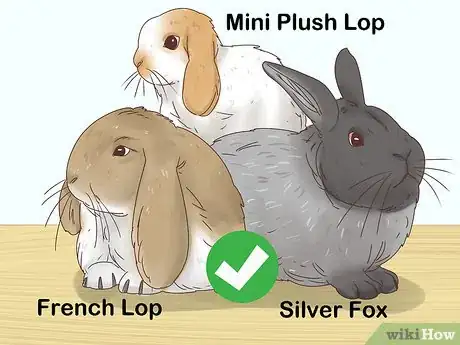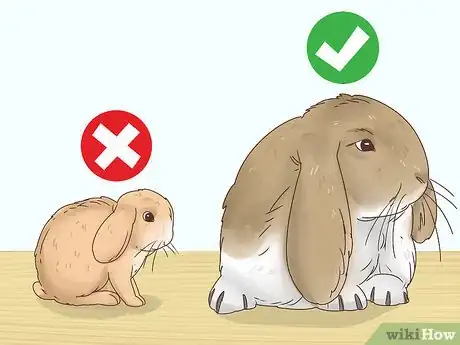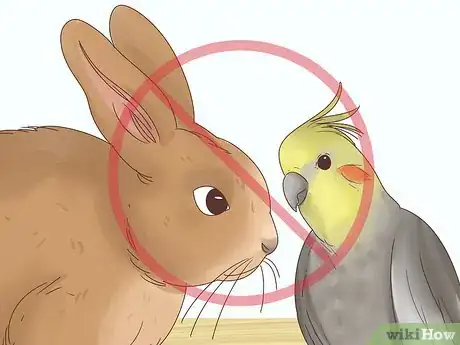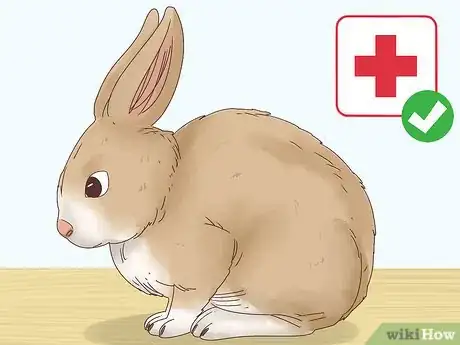This article was co-authored by Ryan Corrigan, LVT, VTS-EVN. Ryan Corrigan is a Licensed Veterinary Technician in California. She received her Bachelor of Science in Veterinary Technology from Purdue University in 2010. She is also a Member of the Academy of Equine Veterinary Nursing Technicians since 2011.
There are 7 references cited in this article, which can be found at the bottom of the page.
This article has been viewed 41,675 times.
A rabbit can be a wonderful, loving pet. With so many breeds to choose from, however, picking a rabbit can feel overwhelming. Spend some time evaluating the temperament of various breeds. Pick a rabbit that fits in with your household. Think about practical considerations, like cost and care. With a little diligence, you should be able to find the perfect pet for your household.
Steps
Choosing the Right Temperament
-
1Choose breeds that will get along with kids. If you have children, make sure you pick a rabbit that gets along well with younger people. Some rabbits tend to be more child-friendly than others, so make sure to read up on whether a breed is patient with kids before making a decision.
- Some breeds tend be nippy and may bite or scratch when handled improperly. Smaller breeds, like the Netherland Dwarf for example, are generally less suitable for kids.[1] Belgians hares are somewhat fragile and may be injured easily through mishandling, so they may not do well in homes with young children.[2]
- French lops tend to be very sociable, so they may make great family pets.[3] Dutch rabbits tend to do well with children.[4]
-
2Find a sociable breed. Ideally, a pet should be friendly and social. Look for a breed that has a reputation for having a friendly personality when choosing a rabbit breed. Many rabbits do not like to be picked up, which can make them a challenging starter pet. Finding the right breed is very important.Advertisement
-
3Watch out for breed-specific temperament issues. Some breeds have known temperament issues. While not all rabbits of a specific breed will have the same issues, it's worth knowing if there are any temperament issues to watch out for when considering a breed.
- Britannias, for example, may be prone to nipping issues. If you're considering this breed, watch out for nipping when visiting a rabbit you're considering adopting.[7]
- Some breeds are the opposite and need a lot more human interaction and attention than others, such as the Lionhead rabbit. While they can make for good lap pets, they may not be the best choice if you don’t have much time available.[8]
- English spots may sometimes have a more nervous temperament.[9]
Making Practical Considerations
-
1Size can be deceiving, many people believe that a smaller rabbit needs less space, but the space needed depends on energy level, not size. A younger rabbit, or a more energetic breed such as a Netherland Dwarf may actually need more space. If you have kids, you may actually want a larger rabbit. Children are more likely to accidentally injure smaller breeds through improper handling.[10]
-
1Avoid angoras and English lops if you're inexperienced. English lops have long ears that can easily get infected through being dragged across the ground. Angoras have long fur that requires extensive grooming. Unless you have had rabbits before, and know how to deal with issues like infections and grooming, it's a good idea to avoid breeds that have special needs. First time rabbit owners should go for breeds that require less extensive care.[11]
-
2Make sure you have enough space. Rabbits need 24/7 access to an exercise space, therefor should be kept in at least a 3x4 foot pen, bigger is always better, and exercise pens are far cheaper than cages and hutches. Rabbits are most active at dawn and dusk, and sleep during the middle of the day, so only giving them room to run around on your schedule can lead to a very bored and sad bunny. Before you pick your rabbit breed, make sure you have the space in your home to provide a big enough pen, or better yet free roam as you would a dog or cat. Remember exercise is important for your rabbit's well being.[12]
-
3Review breed-specific health problems. Some breeds may be prone to health problems or require special diets. This can cost extra money over the years. Before choosing a rabbit, ask the breeder or pet store what health problems you can potentially expect from the breed.
- For example, French angoras, American fuzzy lops, and giants need special diets to thrive. This can potentially cost extra money.[13]
- Some long haired breeds require more brushing and coat care to keep them healthy, prevent hairballs and massive shedding.
- Mini Lops tend to be more prone to ear infections and dental issues, but they are one of the most family friendly breeds.
Avoiding Common Mistakes
-
1Take your other pets into account. Rabbits can sometimes get along with dogs, cats, and other pets during supervised interactions. However, not all pets are appropriate to keep in the same house as a rabbit. Ferrets tend to prey on rabbits and birds can be loud and disruptive, which can cause a rabbit undue stress. If you have a bird, keep it separate from your rabbit.
- Dogs and cats often learn to get along with rabbits, but supervised interactions are important. Some rabbits, however, never learn to get along with cats and dogs. If a rabbit is a more timid breed, or simply has a more timid personality, it may not do well in a house with cats and dogs.
- If you have a herding, driving, or terrier breed dog you may not want to get a rabbit, as these breeds are hardwired to chase after small game. It may be very challenging and dangerous to bring a rabbit into the mix, but make your best judgment based on the behavior of your individual pet.
-
2Meet a rabbit to learn its temperament. Do not choose a rabbit based on breed alone. You should always meet a rabbit in person a few times and spend time holding and interacting with it before deciding to adopt it. Even if a breed is known for having a friendly temperament, an individual rabbit may display behavioral issues depending on its history.[14]
-
3Avoid rabbits if you have very young children. Older children can usually do well with rabbits, but very young children should not keep rabbits as pets. Children who have not yet developed motor skills can seriously injure rabbits through mishandling.[15]
-
4Make sure any rabbit you choose is healthy. A healthy rabbit will be alert and energetic. Their fur should be shiny and even with no patches of hair loss or evidence of external parasites. They should not appear either bony or overly fat with pockets of fat build up. Before choosing a rabbit, run your hands over both sides to check for lumps and bumps. You should also make sure both sides of the rabbit feel the same.[16]
- When choosing a rabbit from a breeder or pet store, ask if the rabbit has any preexisting health conditions or special needs before deciding to adopt it.
-
5Take allergies into consideration. If you've never had a rabbit before, it's possible a household member could be allergic, but it could also be the hay. If you get a rabbit, and you start having issues try changing the type of hay, before rehoming the rabbit. Make sure everyone in your home meets the rabbit before you adopt it and watch for things like sniffling, sneezing, and other signs of an adverse allergic reaction. People with cat allergies may be more likely to be allergic to rabbits.[17]
- Rabbits also need hay to thrive, so it's a bad idea to get a rabbit if someone in your household has a hay allergy.
References
- ↑ http://www.rabbitbreeds.org/rabbit-breeds-small.php
- ↑ http://www.rabbitbreeds.org/rabbit-breeds-medium.php
- ↑ http://www.rabbitbreeds.org/rabbit-breeds-large.php
- ↑ http://www.rabbitbreeds.org/rabbit-breeds-small.php
- ↑ http://www.rabbitbreeds.org/rabbit-breeds-large.php
- ↑ http://www.rabbitbreeds.org/rabbit-breeds-small.php
- ↑ http://www.rabbitbreeds.org/rabbit-breeds-small.php
- ↑ http://www.petmd.com/rabbit/slideshows/5-most-popular-rabbit-breeds
- ↑ http://www.rabbitbreeds.org/rabbit-breeds-medium.php
- ↑ http://rabbitresource.org/care-and-health/you-and-your-rabbit/choosing-your-pet-rabbit/
- ↑ http://rabbitresource.org/care-and-health/you-and-your-rabbit/choosing-your-pet-rabbit/
- ↑ http://rabbitresource.org/care-and-health/you-and-your-rabbit/choosing-your-pet-rabbit/
- ↑ http://www.rabbitbreeds.org/rabbit-breeds-medium.php
- ↑ http://rabbit.org/thinking-of-adopting-a-rabbit/
- ↑ http://rabbit.org/thinking-of-adopting-a-rabbit/
- ↑ https://www.avma.org/public/PetCare/Pages/Selecting-a-Pet-Rabbit.aspx
- ↑ http://rabbitresource.org/care-and-health/you-and-your-rabbit/choosing-your-pet-rabbit/
About This Article
When choosing a breed of rabbit, consider the kind of temperament you want. For example, if you have kids, pick a sturdy, easy-going breed like a French Lop. If you’re looking for a cuddly and sociable pet, go for breeds like the Silver Fox or Mini Plush Lop. Additionally, watch out for breed-specific issues that may be a problem, such as the Britannia’s tendency to nip or the Lionhead’s clingy personality. You’ll also need to account for practical issues, such as how much space you have. For instance, don’t pick a large breed if you can’t offer it lots of room. Read on for more tips from our Veterinarian co-author, including how to avoid common mistakes when choosing a rabbit!






































































